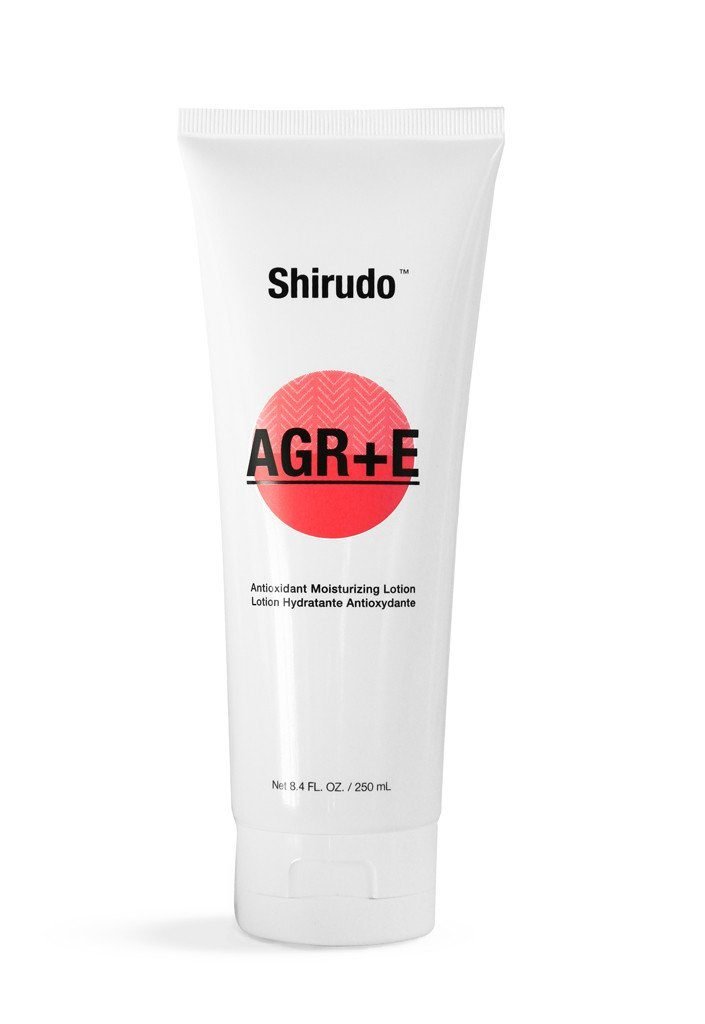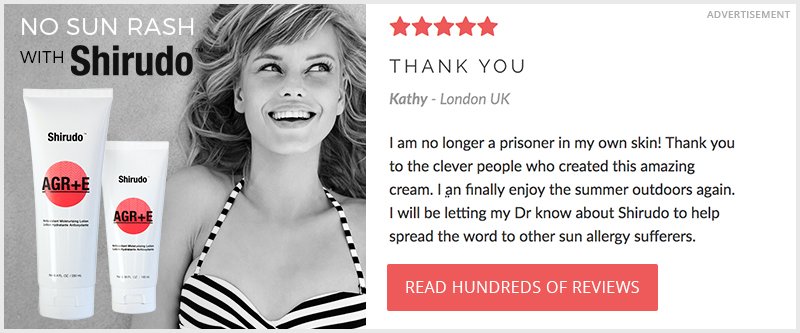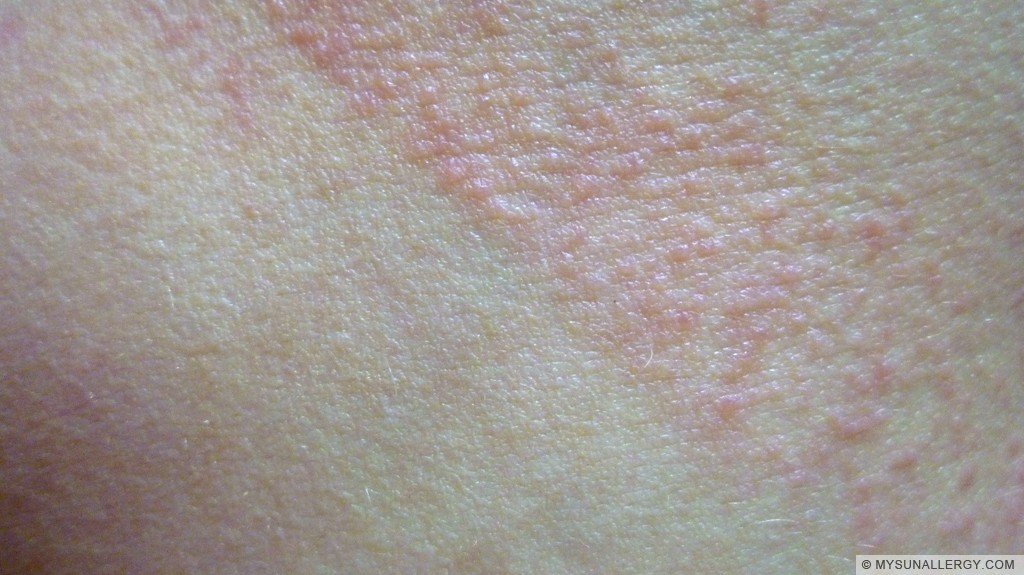You think you are allergic to the sun? Yes it’s totally possible, and you are not alone! It is known to affect more than 10% of North-Americans. A sun allergy (also called sun poisoning, sun rash and photo-dermatitis) is a reaction to sunlight, most often characterized as an itchy skin rash. A sun allergy is not a sunburn but might feel like it. It takes the form of a skin rash or tiny blisters. It is very uncomfortable and will ruin your holiday or Summer! It can be cause by many condition, let’s have a look at the most common.
1. Polymorphous Light Eruption (PMLE) : The Most Common Sun Allergy :
PMLE is the most common sun allergy and by far, affecting 10% of North Americans. If you have sun allergy symptoms, PMLE is the first probable diagnosis. Statistically, you have 3225 more chances to suffer from Polymorphous Light Eruption than solar urticaria, for example. That’s how common PMLE actually is! You may even be able to diagnose the problem yourself. The rash occurs only on sun-exposed skin during early spring (or a winter vacation in the Caribbean, for example) then gradually becomes less severe (or disappear) within the following few days or weeks. In most cases, your doctor can confirm that you have PMLE based on your symptoms, story and family history.

PMLE main symptoms include:
• An itchy or burning rash typically occurring within 2 to 24 hours after sun exposure.
• The rash usually appears on sun-exposed portions of the neck, upper chest, arms and lower legs. It could be all over for very sensitive person.
• It may be accompanied by chills, headache and nausea.
• Through repeated sun exposure, the person may become less sensitive to sunlight and the PMLE rash may disappear completely or gradually become less severe. Although the effects of this desensitization process (also called “hardening) usually lasts through the end of summer, the PMLE rash returns at full intensity the following Spring.
• A PMLE rash usually disappears within two to three days if further sun exposure is avoided. It could last more than fifteen days it skin is still sun exposed.
Natural Preventive PMLE Treatment: Shirudo AGR+E
If you want to avoid medication, Shirudo AGR+E is a fully natural moisturizing lotion that uses the benefits of alpha-glucosylrutin and vitamin E to protect skin against oxidative elements. Shirudo AGR+E is suitable for sensitive skin, ultra-light and quickly absorbs. Fragrance free. You can keep using your favorite sunscreen.

Shirudo most popular product: AGR+E Body Lotion
The original AGR+E light formulation. Use every 2 hours of sun exposure, massage well and apply sunscreen on top. Available in 100ml and 250ml tubes.
Learn more
SOME REVIEWS
Shirudo AGR+E is the best thing I’ve used. My PMLE has progressively got worse for the past 10 years, to the point of steroids being taken. I even broke out during December! This definitely works! Thank you for making this, don’t ever stop. »
– Esther, USA
«I now swear by Shirudo AGR+E! It’s as simple to use as putting sunscreen. I didn’t have a single breakout after being on a sailboat for 9 days. No late nights staying up in pain, no scratching feverishly. »
– Carolyn, ON Canada
« Your product is so effective
– Marie, Mont Sinai NY – USA
I have to thank you sincerely for your wonderful antioxidant lotion!! For years I suffered with PMLE and could not enjoy the outdoors, much less a vacation in a sunny destination. Because your product is so effective, I no longer have a problem! Thank you, Thank You! »
« I truly believe this lotion will finally be able to provide hope and help to PMLE sufferers who don’t want to avoid the sun completely!
– Lindsey, Kentucky
I began experiencing PMLE , or sun allergy, symptoms of varying degrees as a young teen. For years I’ve searched for products that could lessen or completely prevent the terrible itching and bumps that would appear every time I vacationed at the beach or spent a lot of time in the sun. I received this lotion in late July… just before leaving for a California beach vacation. I used the lotion as recommended: Before sun exposure and then reapplying every 2 hours while in the sun. I used SPF 4, 8, and 15 (so nothing above 15) while in the sun, over top of the Shirudo lotion. I did not develop ANY PMLE symptoms while on my vacation and came back with an amazing tan! »
The Science Behind AGR+E

What clinical studies have found ? Studies by Jeanmougin et Al on PMLE sufferers under real solar exposure condition (Spring and Summer) reveal global efficacy of 80%. PMLE sufferers applied a formulation combining alpha-glucosylrutin and Vitamin E with a broad spectrum sunscreen every 2 hours. After summer:
67.3% had no eruptions at all
19.2% had minor eruptions
13.5% had severe eruptions
Less common sun allergies
2. Photoallergic eruption (new medication?)
Are you using a new medication or a new body lotion? Photo-allergic eruption is triggered by the effect of sunlight on a chemical that has been applied to the skin (more often an ingredient in sunscreen, fragrances and cosmetics) or ingested, such as prescription medication. This usually causes an itchy red rash or tiny blisters. In some cases, photo-allergic eruption spreads to skin covered by clothing. Common prescription medication that can cause a photo-allergic eruption include antibiotics, diuretics for high blood pressure and heart failure, and certain oral contraceptives. In most cases, skin symptoms disappear after the offending chemical is identified and no longer used.
Here is a list of the 30 most common substances causing photosensitivity https://mysunallergy.com/30-substances-that-can-cause-sun-rash/
3. Solar urticaria (very very rare- 3.1 per 100,000 people)
This form of sun allergy is a very rare condition. It produces hives (large, itchy, red bumps) on sun-exposed skin. Solar urticaria most often affects young women. Hives usually appear on uncovered skin within minutes of exposure to sunlight. Symptoms typically fade within 30 minutes to 2 hours. However, they usually come back when skin is exposed to sun again.
Other Sun Allergies Diagnosis
If you have mild symptoms of PMLE, you may be able to diagnose the problem yourself only looking at the most obvious symptoms. For example, the sun rash occurs only on sun-exposed skin during early Spring or a winter vacation in the Caribbean. It will then gradually becomes less severe (or disappear) within the following few days or weeks. In most cases, your doctor can confirm that you have PMLE based on your symptoms, story and family history.
If you have symptoms of a photo-allergic eruption, your doctor will begin by reviewing your current medication as well as any skin lotions, sunscreens or colognes you use. The doctor may suggest that you temporarily switch to an alternate medication or eliminate certain skincare products.
Solar urticaria is a rare condition, your doctor may confirm the diagnosis by using photo-testing alone to reproduce your hives.
Sun allergy treatment
If you are prone to sun allergies, prevention (and reduced sun exposure) is the key to avoiding symptoms from worsening:
• Apply a sunscreen with broad-spectrum protection against the sun’s UVA and UVB
• Limit your time outdoors when the sun is at its peak
• Use sunglasses with ultraviolet light protection
• Wear long pants, a long-sleeve shirt and a hat with a wide brim
Be aware of any skincare products and medications that may trigger a photoallergic eruption. If you are taking prescription medication, and you normally spend a great deal of time outdoors, ask your doctor whether you should take any special precautions to avoid sun.

In conclusion, if you suffer from Polymorphous Light Eruption (PMLE) and still want to enjoy outdoor activities, learn more about the effect of alpha-glucosylrutin and vitamin E as a treatment for PMLE prone skin.


Hi again Eloise. No need to reply to my question from about 15 min ago. I found your answer in a Facebook post on the PMLE page! Thanks for sharing all your knowledge BTW!
Hi Eloise. If the combo of AGR+E and a sunscreen should be applied every 2 hours while in the sun, won’t those repeated layers build up and cause clogged pores that could encourage PMLE eruptions? Do previous layers need to be washed off first?